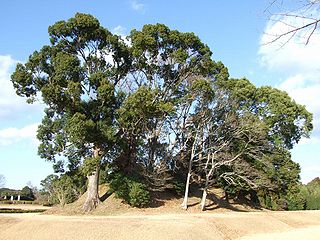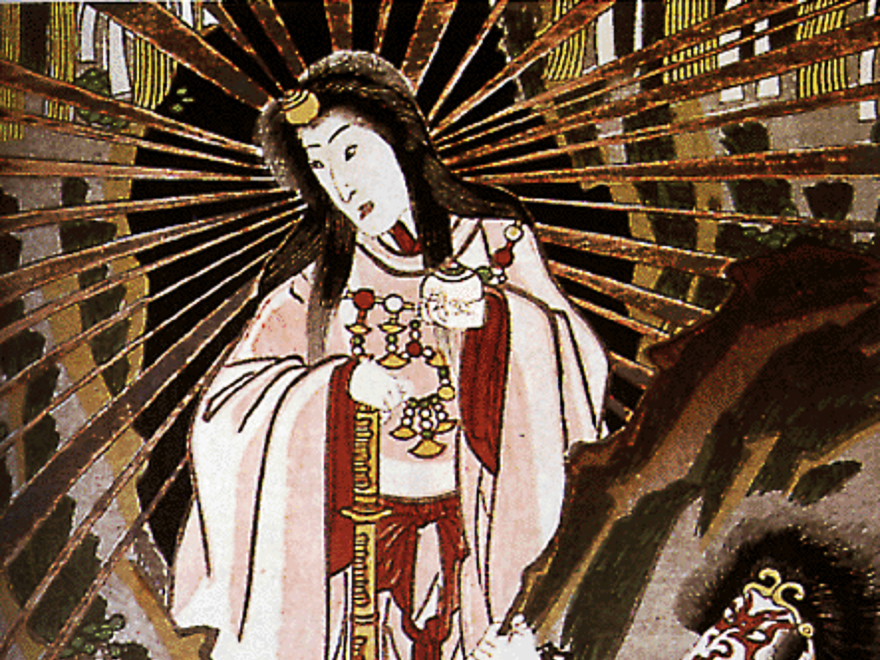 W
WThe Eta Funayama Kofun is a kofun, or burial mound, that is located in Nagomi, Kumamoto in Japan. The Kofun was designated a National Historic Site of Japan in 1951. The designation includes Tsukabōzu Kofun (塚坊主古墳) and Kokuzōtsuka Kofun (虚空蔵塚古墳). Artifacts that were excavated from Eta Funayama Kofun and have been designated National Treasures of Japan are now at the Tokyo National Museum.
 W
WHotarumaru is an ōdachi forged by the swordsmith Rai Kunitoshi (来国俊) and an Important Cultural Property of Japan.
 W
WThe iron Inariyama burial-mound sword or kinsakumei tekken (金錯銘鉄剣) was excavated at the Inariyama Kofun in 1968. Inariyama Kofun is a megalithic tomb located in Saitama Prefecture. In 1978, X-ray analysis revealed a gold-inlaid inscription that comprises at least 115 Chinese characters. This sword was described as the discovery of the century for the study of ancient Japanese history. The sword is designated a national treasure of Japan.
 W
WThe Kogarasu Maru (小烏丸), or "Little Crow Circle", is a unique Japanese tachi sword believed to have been created by legendary Japanese smith Amakuni during the 8th century AD.
 W
WKusanagi-no-Tsurugi is a legendary Japanese sword and one of three Imperial Regalia of Japan. It was originally called Ame-no-Murakumo-no-Tsurugi , but its name was later changed to the more popular Kusanagi-no-Tsurugi. In folklore, the sword represents the virtue of valor.
 W
WThe term "National Treasure" has been used in Japan to denote cultural properties since 1897, although the definition and the criteria have changed since the introduction of the term. The swords and sword mountings in the list adhere to the current definition, and have been designated national treasures according to the Law for the Protection of Cultural Properties that came into effect on June 9, 1951. The items are selected by the Ministry of Education, Culture, Sports, Science and Technology based on their "especially high historical or artistic value". The list presents 110 swords and 12 sword mountings from ancient to feudal Japan, spanning from the late Kofun to the Muromachi period. The objects are housed in Buddhist temples, Shinto shrines, museums or held privately. The Tokyo National Museum houses the largest number of these national treasures, with 20 of the 122.
 W
WTotsuka-no-Tsurugi is not a specific sword, but a common noun for any sword of this length. In Japanese mythology, numerous deities own a sword of this kind. Some examples of well-known Totsuka-no-Tsurugi:The totsuka sword used by Izanagi to kill his offspring Kagu-tsuchi. This one is also named Ame-no-Ohabari or Ama-no-Ohabari . The totsuka sword used in the oath between Amaterasu and Susanoo. Amaterasu received this sword from Susanoo, snapped it to three pieces, and created the Three Munakata Goddesses from its debris. This sword was not named. Another totsuka sword in Susanoo's possession, which he used to slay Orochi. This sword is also named Ama-no-Habakiri or Ame-no-Habakiri (天羽々斬), Worochi-no-Aramasa (蛇之麁正), or Futsushimitama-no-tsurugi (布都斯魂剣). The sword is enshrined as the shintai of Isonokami Shrine. The totsuka sword wield by Takemikazuchi in quelling of the Middle Country. This sword is known as Futsunomitama-no-tsurugi (布都御魂剣), and is the main enshrined dedication in Isonokami Shrine.